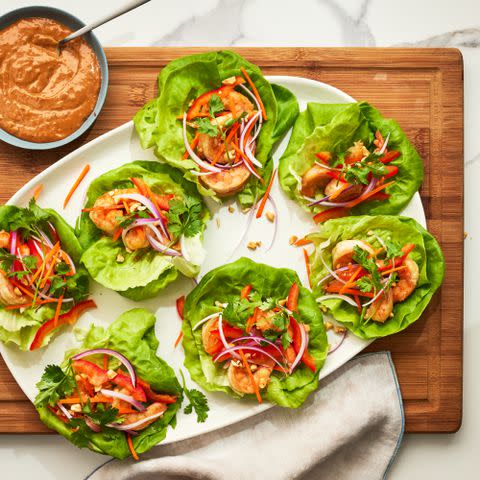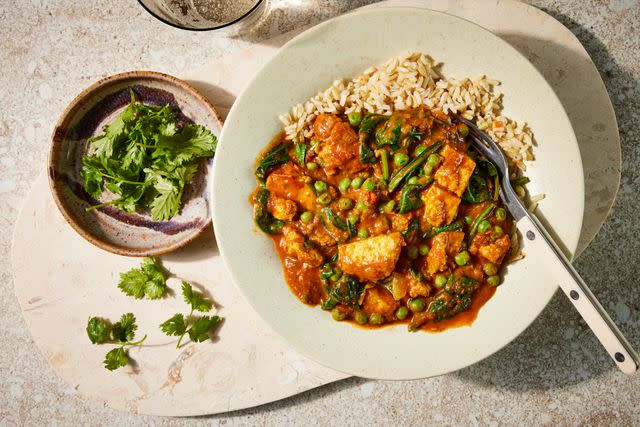Improve your blood sugar by filling up on protein and fiber in this 7-day meal plan.

Reviewed by Dietitian Jessica Ball, M.S., RDReviewed by Dietitian Jessica Ball, M.S., RD
In this seven-day meal plan for better blood sugar, we combine forces and prioritize two nutrients that help promote stable energy and mitigate blood sugar spikes: protein and fiber. Fiber, a type of indigestible carbohydrate, has many health benefits, including improved blood sugar. Protein is also linked to better blood sugar management and a reduced risk of developing prediabetes and type 2 diabetes. Whether you currently have type 2 diabetes, are at an increased risk of blood sugar disorders or are simply looking for a delicious and filling meal plan, this routine can work for most people. Let’s dig in!
How We Create Meal Plans
Registered dietitians thoughtfully create EatingWell’s meal plans to be easy-to-follow and delicious. Each meal plan meets specific parameters depending on the health condition and/or lifestyle goal it is targeting and is analyzed for accuracy using the nutrition database, ESHA Food Processor. As nutritional needs differ from person to person, we encourage you to use these plans as inspiration and adjust as you see fit.
Related: How Much Protein Do You Need to Eat Every Day?
Why This Meal Plan Is Great for You
Each day provides an average of 106 grams of protein, spread throughout the day, to promote stable blood sugar levels and energy. Because protein is broken down more slowly than carbohydrate foods, pairing protein with carbohydrates can help reduce blood sugar spikes compared to a carbohydrate food eaten alone.
To further stabilize blood sugar levels, we pump up the fiber. Each day provides an average of 37 grams of fiber, which is above the recommended Daily Value of 28 grams of fiber per day. Though fiber is a type of carbohydrate, it’s not digested by the body and doesn’t raise blood sugar levels. Because it’s not broken down, fiber slows down digestion and, like protein, helps reduce blood sugar spikes. Research continuously links a high-fiber diet to improved blood sugar management, in addition to its numerous other health benefits.
We aimed for a moderate level of carbohydrates, with about 35% of total calories coming from carbs. Though the average carbohydrate level comes in at 158 grams per day, 37 grams of that is fiber, which does not raise blood sugar levels in the same way as other types of carbs. Whether you have type 2 diabetes or not, prioritizing high-fiber carbohydrates is helpful for overall health, especially considering that just 7% of adults in the United States meet their daily fiber goals.
This 1,800-calorie meal plan has modifications for 1,500 and 2,000 calories to support those with different calorie needs. While we previously included meal plans and modifications for 1,200 calories, we no longer do. The 2020-2025 Dietary Guidelines for Americans suggests that limiting your calories to 1,200 per day is too low for most people to meet their nutritional needs, plus it’s unsustainable for long-term health and well-being.
Frequently Asked Questions
Is it OK to mix and match meals if there is one I do not like?
Yes, meal plans are meant to be enjoyed. If there’s a recipe you don’t like, feel free to repeat a different recipe listed in this meal plan or check out more of our high-fiber and high-protein recipes. For reference, we aimed for 1,800 calories, a minimum of 95 grams of protein and 33 grams of fiber per day and a maximum of 2,300 milligrams of sodium.
Can I eat the same breakfast or lunch every day?
Definitely. Each breakfast and lunch option is fairly similar in calories and carbohydrates, so a simple swap would work well.
Why is there not a modification for 1,200 calories?
We no longer provide modifications for 1,200-calorie days in our meal plans. The 2020-2025 Dietary Guidelines for Americans suggests that limiting calories to 1,200 per day is too low for most people to meet their nutritional needs, plus it’s unsustainable for long-term health and well-being.
How many carbohydrates should I eat per day?
There is no one-size-fits-all recommendation for the number of carbohydrates to eat per day, as factors such as activity level and body size can play a role. For many people with elevated blood sugar, reducing total carbohydrate intake, prioritizing high-fiber carbs and increasing protein can help improve blood sugar levels. For individual recommendations, reach out to a registered dietitian or certified diabetes educator.
Exercise and Blood Sugar
What we eat plays an important role in blood sugar management, but exercise is an important factor as well. Why? Physical activity improves insulin sensitivity, which means your body is better at using glucose (sugar) in the blood. This positive impact on insulin sensitivity can last for 24 hours post-workout. And, when we’re being active, our muscles take up blood glucose and use it for energy, which lowers blood sugar levels. The American Diabetes Association recommends a weekly goal of 150 minutes of moderate-intensity exercise per week. This may look like a brisk walk, five days a week for 30 minutes, though any physical activity that gets the heart pumping is great. If 150 minutes a week seems daunting, don’t underestimate the power of short bouts of movement. Research links walking for two to five minutes after meals with improved blood sugar levels. Looking for a plan to get started? Check out our 30-Day Walking Plan to Help Lower Your Blood Sugar Levels.
High-Fiber and High-Protein Foods to Focus On
-
Fruits
-
Vegetables
-
Beans
-
Lentils
-
Whole grains (quinoa, brown rice, bulgur, oats and more)
-
Soy, tofu and edamame
-
Eggs
-
Meat
-
Poultry
-
Fish
-
Shellfish
-
Yogurt, kefir and cottage cheese
-
Nuts
-
Nut butters
-
Seeds
How to Meal-Prep Your Week of Meals:
-
Make Sausage, Spinach & Mushroom Egg Bites to have for breakfast throughout the week.
-
Prepare High-Protein Strawberry & Peanut Butter Overnight Oats to have for breakfast on Days 2 through 4.
-
Make Light & Airy Whipped Cottage Cheese to have as a snack throughout the week.
Day 1


Photographer: Jen Causey, Food Stylist: Jennifer Wendorf, Prop Stylist: Lindsey Lower
Breakfast (437 calories, 41g carbohydrate)
A.M. Snack (242 calories, 17g carbohydrate)
Lunch (357 calories, 23g carbohydrate)
P.M. Snack (82 calories, 13g carbohydrate)
Dinner (439 calories, 43g carbohydrate)
Evening Snack (237 calories, 15g carbohydrate)
Daily Totals: 1,793 calories, 90g fat, 103g protein, 151g carbohydrate, 33g fiber, 2,067mg sodium
Make it 1,500 calories: Reduce to 1 Tbsp. sliced almonds at A.M. snack and omit evening snack.
Make it 2,000 calories: Add 2 servings Edamame with Aleppo Pepper to P.M. snack.
Day 2


Photographer Victor Protasio, Food Stylist Julian Hensarling, Prop Stylist Tucker Vines
Breakfast (442 calories, 40g carbohydrate)
A.M. Snack (201 calories, 16g carbohydrate)
Lunch (340 calories, 36g carbohydrate)
P.M. Snack (82 calories, 13g carbohydrate)
Dinner (523 calories, 33g carbohydrate)
Evening Snack (237 calories, 15g carbohydrate)
Daily Totals: 1,825 calories, 97g fat, 97g protein, 152g carbohydrate, 43g fiber, 1,839mg sodium
Make it 1,500 calories: Reduce to 1 serving Edamame with Aleppo Pepper at A.M. snack and omit almonds at evening snack.
Make it 2,000 calories: Add ¼ cup unsalted dry-roasted shelled pistachios to lunch.
Day 3


Photographer: Rachel Marek, Food stylist: Holly Dreesman, Prop stylist: Addelyn Evans
Breakfast (442 calories, 40g carbohydrate)
A.M. Snack (201 calories, 16g carbohydrate)
Lunch (340 calories, 36g carbohydrate)
P.M. Snack (82 calories, 13g carbohydrate)
Dinner (529 calories, 49g carbohydrate)
Evening Snack (206 calories, 16g carbohydrate)
Daily Totals: 1,800 calories, 76g fat, 116g protein, 171g carbohydrate, 38g fiber, 1,596mg sodium
Make it 1,500 calories: Reduce to 1 serving Edamame with Aleppo Pepper at A.M. snack and omit pistachios at evening snack.
Make it 2,000 calories: Add ¼ cup unsalted dry-roasted almonds to P.M. snack.
Day 4


Photographer Victor Protasio, Food Stylist Julian Hensarling, Prop Stylist Tucker Vines
Breakfast (442 calories, 40g carbohydrate)
A.M. Snack (201 calories, 16g carbohydrate)
Lunch (340 calories, 36g carbohydrate)
P.M. Snack (82 calories, 13g carbohydrate)
Dinner (494 calories, 41g carbohydrate)
Evening Snack (234 calories, 23g carbohydrate)
Daily Totals: 1,794 calories, 77g fat, 114g protein, 170g carbohydrate, 39g fiber, 1,575mg sodium
Make it 1,500 calories: Reduce to 1 serving Edamame with Aleppo Pepper at A.M. snack and omit pistachios at evening snack.
Make it 2,000 calories: Add ¼ cup unsalted dry-roasted almonds to P.M. snack.
Day 5


Breakfast (437 calories, 41g carbohydrate)
A.M. Snack (242 calories, 17g carbohydrate)
Lunch (340 calories, 36g carbohydrate)
P.M. Snack (82 calories, 13g carbohydrate)
Dinner (563 calories, 48g carbohydrate)
Evening Snack (118 calories, 5g carbohydrate)
Meal-Prep Tip: Reserve 2 servings Anti-Inflammatory Lemony Salmon & Orzo Casserole to have for lunch on Days 6 and 7.
Daily Totals: 1,780 calories, 86g fat, 98g protein, 160g carbohydrate, 35g fiber, 2,289mg sodium
Make it 1,500 calories: Omit kefir at breakfast, almonds at A.M. snack and orange at lunch.
Make it 2,000 calories: Add ¼ cup unsalted dry-roasted almonds to P.M. snack.
Day 6


Photographer: Jen Causey, Food Stylist: Rishon Hanners, Prop Stylist: Julia Bayless
Breakfast (437 calories, 41g carbohydrate)
A.M. Snack (175 calories, 15g carbohydrate)
Lunch (391 calories, 37g carbohydrate)
P.M. Snack (101 calories, 8g carbohydrate)
Dinner (555 calories, 59g carbohydrate)
Evening Snack (118 calories, 5g carbohydrate)
Daily Totals: 1,776 calories, 83g fat, 103g protein, 165g carbohydrate, 39g fiber, 2,098mg sodium
Make it 1,500 calories: Omit kefir at breakfast and almonds at A.M. snack and omit evening snack.
Make it 2,000 calories: Increase to 2 servings Edamame with Aleppo Pepper at P.M. snack and increase to 2 Tbsp. natural peanut butter at evening snack.
Day 7


Photographer: Morgan Hunt Glaze, Food Stylist: Margaret Monroe Dickey, Prop Stylist: Julia Bayless
Breakfast (437 calories, 41g carbohydrate)
A.M. Snack (211 calories, 18g carbohydrate)
Lunch (391 calories, 37g carbohydrate)
P.M. Snack (101 calories, 8g carbohydrate)
Dinner (535 calories, 25g carbohydrate)
Evening Snack (118 calories, 5g carbohydrate)
Daily Totals: 1,791 calories, 95g fat, 108g protein, 134g carbohydrate, 36g fiber, 1,932mg sodium
Make it 1,500 calories: Omit kefir at breakfast and pistachios at A.M. snack.
Make it 2,000 calories: Increase to 2 servings Edamame with Aleppo Pepper at P.M. snack and increase to 2 Tbsp. natural peanut butter at evening snack.
Read the original article on Eating Well.
Source Agencies

